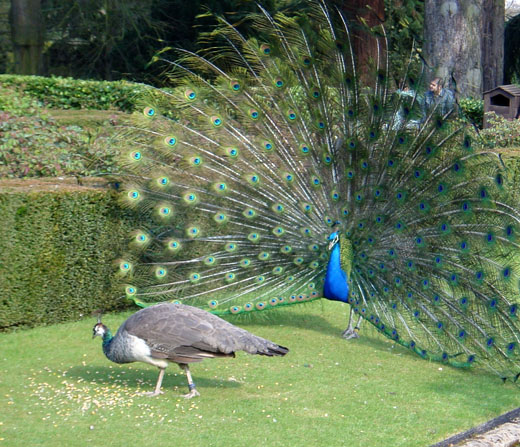The Black hornbill we observed on the 7th of February 2010 was a female(with a possible sighting of a male). We know this because even her bill was black (See post entitled 'Sebana hornbill sightings on 7th Feb 2010'). Males have a contrasting yellow bill, as can be seen from the video clip below. Differences between males and females of a species is sexual dimorphism. Example: Men are usually(though we do admit, there are some real shorties out there) taller than women(disregarding the occasional Amazonian, of course).
The male here has a white stripe above his eye. Males don't always have this though. Some have it, some don't. Looks so much more dashing with the stripe, don't you think? :)
The male here has a white stripe above his eye. Males don't always have this though. Some have it, some don't. Looks so much more dashing with the stripe, don't you think? :)
Male Black hornbill(Anthracoceros malayanus) in Borneo
[Video adapted from this website, on 25th February 2010]
[Video adapted from this website, on 25th February 2010]
Usually animals are sexually dimorphic(Google: Sexual dimorphism) because it gives them a one up on having babies, so they are able to pass on their genes to the next generation and so on and so forth. Sexual selection is usually cited as the cause of sexual dimorphism. How does this work?
An overused example: Peacocks are amongst the most beautiful of birds with their flashy tail feathers. But, you probably wouldn't give a peahen a second look. They're just boring... and brown... and did i mention, boring? It is believed that, in this case at least, over many generations, females keep picking the pretty boys when its 'show time' so males get progressively prettier and prettier finally culminating in the peacock we're familiar with today.
Peacock(right) courting peahen(left)
[Image adapted from this website, on 2nd March 2010]
The science behind it: Pretty males have a major disadvantage. They're pretty! Their long, 'flowing' feathers may catch the eye of predators with voracious appetites. Also, it can't be all that easy getting away when you're trying not to trip over your long, cumbersome feathers. So, if in spite of this seeming hindrance, they are able to survive, there must be something amazing about these guys. Females in wanting only the best for their little chicks, choose them.
Long story short, the disadvantage is actually an advantage.
Take note though that this is just one aspect of sexual selection though- female choice. Other aspects include sperm competition- the ginormous balls of some primates, as enthusiastically discussed several posts ago :)
A little difficult to extrapolate this to the Black hornbills though. Does having a yellow beak rather than a black one really make him look oh-so-much-sexier? Perhaps, like the bare throat-skin patches, they signify the health of the male to the female? Considering that half his genes will be passed on to their offspring, and she is almost entirely dependent on her Prince Charming when she seals herself away in the highest room in the tallest tower*, it's pretty important that she find herself a virile male.
But, the sexual dimorphism exhibited in this species is very limited(there is only a relatively great difference in size and bill), so sexual selection may not play a great part in the lives of these birds. It's not as important as say, in peafowls or the birds of paradise.
Additional note: It is suspected that Black Hornbills breed cooperatively. That is, while one female is cooped up with her little chicks, her mate and other (usually) closely related Black hornbills help to bring food to the happily imprisoned family.
In spite of it possibly being unimportant, makes you wonder though...what's the purpose in having different coloured bills if it doesn't really matter?
Conclusion: Much is known, yet more is unknown
Reference
Zebutionary
highest room in the tallest tower* : Movie reference- 'Shrek'
Kemp, A. (1995). The Hornbills. United States: Oxford University Press Inc., New York.
Zebutionary
highest room in the tallest tower* : Movie reference- 'Shrek'


No comments:
Post a Comment